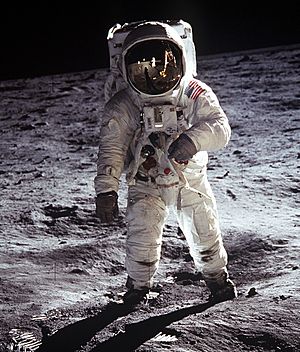Eleanor Foraker facts for kids
Eleanor ("Ellie") Foraker (September 2, 1930 - December 8, 2011) was an American seamstress who played a very important role in NASA's space program. She worked for a company called International Latex Corporation (ILC). Ellie helped create the special A7L spacesuit for the Apollo 11 mission, which took astronauts to the Moon. Later, she also worked on the airbag system for the Pathfinder Mission, helping to land the Sojourner rover safely on Mars.
Ellie's Early Work
Eleanor Foraker was born on September 2, 1930, in Kenton, Delaware. She worked at ILC Dover for 43 years. She started as a seamstress and later became a manager.
In 1964, ILC competed to design spacesuits for the Apollo missions. Ellie was asked to join this special team. She moved from sewing everyday items like cloth diaper covers to sewing advanced spacesuits. From 1968 to 1974, she continued her important work as a supervisor and manager at ILC.
Building Spacesuits for Apollo
Ellie Foraker's most famous work was on the A7L spacesuit for the Apollo program. This suit was designed by the talented seamstresses and engineers at ILC. It was very different from other suit designs.
The seamstresses from the Playtex division created a spacesuit with 21 layers. These layers were carefully sewn and glued together. The suit was soft and flexible, which was a big change from the stiff suits made by other companies.
The spacesuit had to be incredibly strong. It needed to protect astronauts from extreme cold and heat in space. It also had to be flame-resistant and keep astronauts safe from dangerous conditions. The seams on the suit had to be perfect, with almost no extra fabric (less than one sixty-fourth of an inch).
The suits had a rubber layer inside that had to be completely sealed. Even a tiny hole or a forgotten pin could be very dangerous. To make sure no pins were left inside, the suits were X-rayed. Ellie's job as a supervisor included managing the sewing pins. Each seamstress had pins with different colored heads. This way, Ellie could tell who worked on each part of the suit. If a pin was found, the seamstress who left it might get a playful poke!
Teamwork and Dedication
The people working on the spacesuits, both seamstresses and engineers, worked together very well. They respected each other's skills. More seamstresses, all women, were brought from the Playtex division to help. They were encouraged to share their knowledge and teach the engineers how to sew. They also suggested ways to make the suits better.
The project head, Leonard (Lenny) Sheperd, showed great respect for the seamstresses' work. During the final stages of making the suits, he would often stay late with Ellie at the Dover plant. He helped move the big, heavy suits while she sewed them on special sewing machines. These machines were even nicknamed 'Big Moe' and 'Sweet Sue'.
Ellie was also a supervisor at this time. She often worked eighty hours a week, sometimes only leaving the plant for two hours before coming back. Her dedication to creating the spacesuit was amazing. She didn't take any days off or vacations for three years. This intense work was very stressful for her.
A Lasting Impact
The soft and flexible A7L spacesuit became the model for future spacesuit designs. The incredible work done by Ellie Foraker and her team of seamstresses was very important. For a long time, their contributions were not widely known. This is partly because "women's work," especially sewing, has often been seen as less important or less skilled.
However, the huge amount of time, skill, and knowledge these women put into sewing the suits shows how valuable their work truly was. While many names connected to the Apollo missions are famous, the work of the seamstresses like Ellie remained mostly hidden until recently.
In the 21st century, this has started to change. The popular book and movie Hidden Figures helped show the important contributions of Black women mathematicians at NASA. The book Spacesuit: Fashioning Apollo, published in 2011, explains how much work went into the A7L spacesuit. It also recognizes how important the team of seamstresses was.
Inspired by Ellie Foraker's real life, a children's book called The Spacesuit: How a Seamstress Helped Put a Man on the Moon was published in 2019. It tells a story based on her work on the A7L spacesuit.


